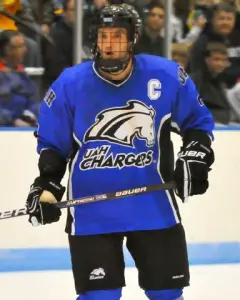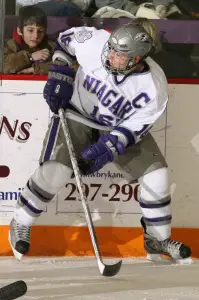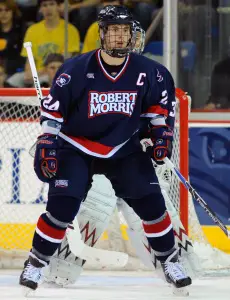Down the Stretch They Come
This is the second-to-last weekend of regular season games in the MIAC, and the playoff picture is as muddy as ever.
The parity in this league becomes more prevalent each week as teams continue to demonstrate that any team can beat anyone else on a given night. The top two teams in the league are separated by only one point, while the third through seventh spots in the standings are separated by only two points.
That’s about as close a league as you can hope for, and it provides exciting hockey each and every week as each game over the course of the season could be the difference between making or missing the playoffs at the end of the year.
If the schedule makers knew what the standings would look like this week, they couldn’t have drawn things up any better.
The top two teams meet in a series that will likely decide the regular season title, the two teams tied for third and fourth face off, fifth and sixth place will be fighting each other tooth and nail for their playoff lives, and the eighth and ninth place teams also battle it out.
With that said, let’s take a look at some of these matchups, and what they mean for the teams involved.
Augsburg vs. St. Olaf
The Auggies are currently sitting in fifth place by themselves, leading the Oles by a single point. With only five teams making the playoffs, this is a huge series for both teams. A successful weekend by either team will see them jump up the standings and put their playoff fate in their own hands.
I spoke to St. Olaf coach Sean Goldsworthy about this upcoming weekend and what he was expecting. Not surprisingly, he’s expecting a close series.
“I’ll be surprised if the games are determined by more than one or two goals†said Goldsworthy. “It’ll come down to special teams and goaltending, whoever can execute the best and focus for 60 minutes should come out on top.â€
These two teams met in a non-conference game earlier in the year, with Augsburg winning 4-3 in overtime. Special teams and goaltending were indeed key, as the Oles’ Krauss turned aside 27 shots and Augsburg’s Zitor turned aside 19. All four of the Auggies’ goals were scored on the power play, while two of St. Olaf’s were scored in like fashion.
It was a hard fought game with several penalties on both sides. I will be shocked if the intensity is any lower this weekend, but will be similarly shocked if there are anywhere close to the 20 combined penalties that occurred in this game.
Both teams have received good goaltending this year. The Auggies have mainly relied on freshman goaltender Justin Lochner’s 2.33 goals against average and .923 save percentage. When in net, he’s led the Auggies to a record of 8-4-1. Behind him though, two other goalies have save percentages above .900, giving Augsburg tremendous depth in goal.
Across the ice, the Oles also have depth in goal, with two solid netminders. Junior Nick Krauss has a 3.07 GAA and .895 save pct., while sophomore Ben Leis (2.53, .916) also has stellar numbers.
“Last year we were blessed with great goaltending, and this year we’re blessed with two solid goalies“, said Goldsworthy. “We feel confident that we can go out and win with either of them in net, and it’s great to have that kind of depth.â€
When it comes to scoring, both teams rely heavily on their top lines to deliver. For St. Olaf, they’ll be looking for a big weekend from forwards Isak Tranvik and Britton Smith, as well as defensemen Caleb Harrison and Derek Grogan. These four players have accounted for over half of their team’s 69 goals this season, and if they produce this weekend, it will be hard to stop the Oles.
The Auggies will be looking for their big three goal scorers (Joel Sauer, Nick Guran, and Chris Johnson) to have a good weekend, as well as assist-machine Jim Jensen to keep making plays. Those four players have accounted for 39 of Augsburg’s 63 goals on the year.
With the top lines and goaltending fairly matched, special teams may play a larger role than normal in this game, and here things tip in Augsburg’s favor. St. Olaf’s penalty kill is pretty much right where it was last season, killing 80.6% of their league opponents’ power plays. The power play however, has taken a big hit, dropping from 23.8% to 12.7%.
This is one of the reasons that the Oles’ scoring is down this season, and they’re going to have to be able to convert on the power play if they want to be able to make a run in the playoffs. One thing that may help the Oles is they are one of the least penalized teams in the league, averaging only 13.2 penalty minutes per game.
For Augsburg, their power play is clipping along at a healthy 21.7% in conference games, and their penalty kill is much improved this season. Last season the Auggies were dead last in the MIAC, killing off only 72% of their penalties. This season? They’re up to 85.2% on the penalty kill, one of the main reasons their combined special teams rank third in the league.
“Our goals against have improved a lot this season†said Auggie coach Chris Brown. “Consistent goaltending and a better penalty kill are a big reason for that improvement, now we need to focus and hopefully peak at the right time.â€
One thing the Auggies could do a little better is close out their games. Over the course of the season as a whole, they’ve outscored their opponents in the first and second periods, but have been outscored in the third.
“We need to finish games a little stronger, I think. You win by going out there and being aggressive, doing things that got you the lead in the first place, not by sitting back and hoping not to make a mistake. We need to actively forecheck and create some pressure late in the game, and if we do, good things should happen.â€
This would definitely be the right time to be playing your best hockey. The games this weekend have a playoff feel to them, and it’s not even the last weekend of the season. Big matchups now set up potentially bigger ones next week, and then it’s right into the conference playoffs.
“This is a great time of year for the league†said Goldsworthy. “It really shows the parity of the league with so many teams fighting for the playoff spots, and it’s great for the fans and the players to have meaningful games all season long.â€
These types of series are great to follow and with so many of them the last few weeks, it makes for exciting hockey across the league. Whoever is playing their best hockey this time of year will be able to move up the standings and have a shot at taking the conference playoffs and earning a spot in the NCAA tournament.
For some teams, the playoffs have already begun, as these series will determine who will be on the outside looking in when the league tournament begins.
Now, let’s take a look at the biggest series of the weekend, as two teams fight for first place in the conference.
Hamline vs. Gustavus Adolphus
No matter what happens this weekend, Hamline and Gustavus Adolphus will be the top two teams when it’s over.
What’s up for grabs though is which team will be in first place. Currently the Gusties hold a one point lead over the Pipers, and control their own destiny. If Gustavus wins a game this weekend they’re assured of being in first place going into their final series against last place St. Mary’s.
For the Pipers to claim first, they’re going to have to come away with at least a win and a tie. This makes Friday’s game at Gustavus a huge one; its outcome will determine just how important Saturday’s game is.
When you look at the team’s records, goals scored, and goals against, it’s clear that they are very even. Gustavus is 9-1-2 in conference games, scoring 52 goals and giving up only 27. Hamline is 9-2-1 and has scored 53 goals while giving up 30. Gustavus ranks first in scoring defense and second in offense while Hamline is second in scoring defense and first in offense.
Looking at goaltending, Gustavus’ Josh Swartout has a 2.21 GAA and .909 save pct.. Gustavus’ opponents average only 25.1 shots per game, and with a solid goalie facing limited shots, it’s tough to score enough goals to beat the Gusties.
For Hamline, Beau Christian has struggled slightly lately, but head coach Scott Bell has confidence in his goaltender.
“He went through a little rough stretch, but we’ve worked some things out, and we feel real good about his play going into this weekend,, said Bell.
Possibly the best goalie in the league for the first half of the season, Christian’s numbers (2.41 GAA, .906 save pct.), which are solid by any stretch, especially for one who’s gone through a rough stretch.
Hamline’s offense isn’t centered around a dominant top line, instead it’s spread fairly evenly around the team, with eight players scoring five or more goals.
Only Kyle Kurr has scored more than 10 goals (13) this season, but when combined with Brian Arrigoni, Chris Berenguer, Ryan Kupperman, and Spencer Anderson, the points add up quickly. This depth in scoring puts a lot of pressure on other teams, as the Pipers can exploit matchups with opponents’ third or fourth lines.
Across the ice, Gustavus has five of their own players with five or more goals. Leading the way is senior David Martinson, who leads the nation in goals scored with 23 markers this season. He’s a danger whenever he’s on the ice, with six power-play goals, two shorthanded goals, and 15 even-strength goals.
He also leads the MIAC with five game-winning goals. Ross Ring-Jarvi may sometimes be overshadowed by Martinson, but with 11 goals and 19 assists, his 30 points are extremely valuable. Eric Bigham and Brad Wieck also add some scoring punch.
On the power play, Hamline leads the MIAC, converting 25.8% of the time in league games. The Gusties are third in the league with a 21.1% rate. On the penalty kill, Hamline is second in the league with a 88.4% kill rate while the Gusties are third with 86.7%.
While these may seem to favor Hamline slightly, Gustavus does have an interesting wrinkle to their statistics: they lead the nation in shorthanded goals. The Gusties might have a worse penalty kill than Hamline, but their nine shorthanded goals compensate for that. It isn’t just Martinson here, five different players have scored shorthanded, including three by Ring-Jarvi. Underestimating the Gusties’ speed can be deadly.
Friday’s game between these two teams is a big one.
A Gustavus win will take some of the drama out of Saturday, as any win by Gustavus means they’ll stay in first place after the series. A Piper win will make Saturday’s game one of the biggest of the year, as the Gusties will be fighting to retake first while Hamline will be going to battle to hold on to it.
This should be a fast paced back and forth game with plenty of scoring chances and hard hits. Whoever ends up on top will have certainly earned it by defeating one of the top teams in the league. It’s fitting that the fight for first place will likely be decided head to head at the end of the season.
Predicting the Impossible
On any given week, it’s hard to make predictions in this league. Despite seeing over 20 MIAC games this season and seeing each team play multiple times, often it seems like a coin flip no matter what the teams records are or where they are in the standings. The parity and quality in this league is difficult to gauge if you’ve never seen the teams play, and their records can often be deceiving.
Predicting splits is tricky, since even if you think two teams might split, it’s hard to guess which game will be won by whom. Like last week’s series with St. Olaf and St. Thomas showed, home ice doesn’t always count for that much. St. Thomas went down to St. Olaf and beat them in their own rink, then lost 5-2 at home the next night. Often it’s just impossible to know who is going to win or when, the parity is that prevalent.
So far this season with my predictions I have a record of 56-31-11, which isn’t too shabby. That said, this weekend has me at a loss. Each team plays a team either directly below, above, or tied in the standings, meaning the games should be closer than ever. I might as well be served picking teams out of a hat this week.
If you think you can pick this weekend correctly, send me an email at [email protected]. Anyone who predicts the outcomes better than I do this weekend will get a special mention in next week’s column.
Greater than The Game
Often times fans focus solely on the win-loss column of their favorite teams as they cheer them on. It sometimes gets lost that these hockey players are college students as well, and there is a lot more to them than what we see on the ice.
On Feb. 2, the nominees for the 2010 Hockey Humanitarian award were announced. Several men and women, from Division I and D-III schools were nominated, 18 in all. Among them is junior Mario Mjelleli of Augsburg College. The Hockey Humanitarian Web site states:
“The Hockey Humanitarian Award is awarded annually to college hockey’s finest citizen and seeks to recognize college hockey players, Division I or Division III, male or female, who give back to their community in the true humanitarian spirit. It has been said of the Hockey Humanitarian Award that we seek not to celebrate Hall of Fame athletes, but rather Hall of Fame human beings.â€
While at Augsburg, Mario has been involved with several volunteer programs, including with the Herb Brooks Foundation, serving as a volunteer coach to teach inner city children hockey fundamentals and skills. He’s also raised money for wheelchairs for the Twin Cities Shriner hospital, served as an instructor for Hockey Ministries International Christian Hockey Camp, again helping children.
And that’s just the tip of what he’s been involved in. Mario has also volunteered in his hometown of Faribault, Minn.. He’s helped collect historical hockey memorabilia of the town to preserve its hockey history, he’s organized drives to collect used hockey equipment for the town’s youth program as well as helping raise money for them.
Mario was a large part of organizing a celebrity golf event and celebrity hockey game this past summer in Faribault. The game and golf event featured Shattuck-St. Mary’s alumni vs. ‘the world’. Featured in the game were 30 NCAA or NHL players, with the proceeds going to the Faribault Hockey Association and local youth hockey. The events are estimated to bring in between $10,000 and $25,000, money that helps local children play hockey without their parents having to break the bank to do so.
Mario’s brother Marty (a 2008 nominee for the Humanitarian award) both help organize the event, as well as use their contacts to get players to join in. All this while neither of them are originally from the town, but want to give back to the town where they developed as hockey players.
College hockey players are a special bunch. They spend 60 minutes every game trying to outskate, outwork, check, and beat their opponents, but line up immediately after the game to shake their hands. No matter the outcome of the game, their love for the game itself tends to transcend it. Maybe that’s why there are people like Mario Mjielleli who are so willing to give back to their communities.
Casual fans might focus only on wins and losses, goals and hits, hat tricks and records. But if they are, they’re missing out on something bigger than the game they’re watching. This desire to help other people experience the game for themselves, the push to help them develop both as hockey players as well as young men and women, this is what the spirit of hockey is all about, and is greater than anything that can be done on the ice.



